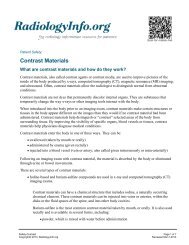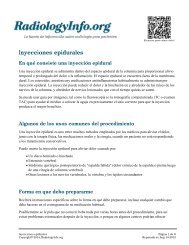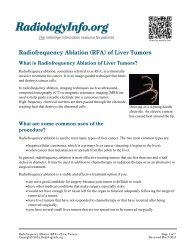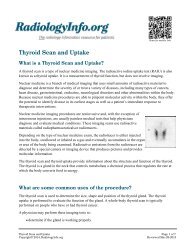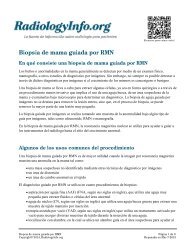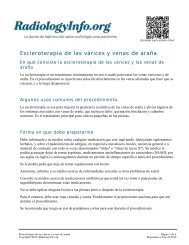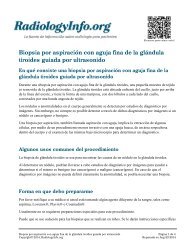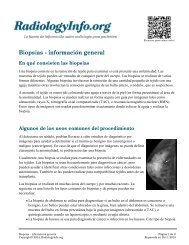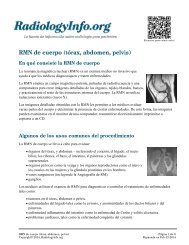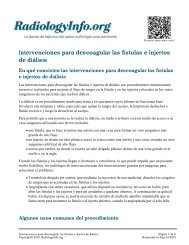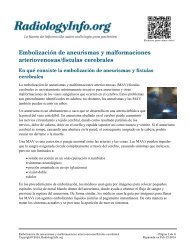Obstetric Ultrasound - RadiologyInfo
Obstetric Ultrasound - RadiologyInfo
Obstetric Ultrasound - RadiologyInfo
You also want an ePaper? Increase the reach of your titles
YUMPU automatically turns print PDFs into web optimized ePapers that Google loves.
Scan for mobile link.<strong>Obstetric</strong> <strong>Ultrasound</strong>What is <strong>Obstetric</strong>al <strong>Ultrasound</strong> Imaging?<strong>Ultrasound</strong> is safe and painless, and produces pictures of the inside of the body using sound waves.<strong>Ultrasound</strong> imaging, also called ultrasound scanning or sonography, involves the use of a smalltransducer (probe) and ultrasound gel placed directly on the skin. High-frequency sound waves aretransmitted from the probe through the gel into the body. The transducer collects the sounds that bounceback and a computer then uses those sound waves to create an image. <strong>Ultrasound</strong> examinations do not useionizing radiation (as used in x-rays), thus there is no radiation exposure to the patient. Becauseultrasound images are captured in real-time, they can show the structure and movement of the body'sinternal organs, as well as blood flowing through blood vessels.<strong>Ultrasound</strong> imaging is a noninvasive medical test that helps physicians diagnose and treat medicalconditions.<strong>Obstetric</strong>al ultrasound provides pictures of an embryo or fetus within a woman's uterus, as well as themother's uterus and ovaries.A Doppler ultrasound study may be part of an obstetrical ultrasound examination.Doppler ultrasound is a special ultrasound technique that evaluates blood flow through a blood vessel,including the body's major arteries and veins in the abdomen, arms, legs, neck and head (in infants andchildren).During an obstetrical ultrasound the examiner may evaluate blood flow in the umbilical cord or may, insome cases, assess blood flow in the fetus or placenta.What are some common uses of the procedure?<strong>Obstetric</strong>al ultrasound is a useful clinical test to:establish the presence of a living embryo/fetusestimate the age of the pregnancydiagnose congenital abnormalities of the fetusevaluate the position of the fetusevaluate the position of the placentadetermine if there are multiple pregnancies<strong>Obstetric</strong> <strong>Ultrasound</strong> Page 1 of 6Copyright© 2014, <strong>RadiologyInfo</strong>.orgReviewed Jul-16-2013
determine the amount of amniotic fluid around the babycheck for opening or shortening of the cervixassess fetal growthassess fetal well-beingSome physicians also use 3-D ultrasound to image the fetus and determine if it isdeveloping normally.How should I prepare?You should wear a loose-fitting, two-piece outfit for the examination. Only the lower abdominal areaneeds to be exposed during this procedure.The radiologist or sonographer may elect to examine an early pregnancy by means of transvaginalultrasound in order to see the pregnancy more closely or to assess the cervix. For more information ontransvaginal ultrasound, see the Pelvic <strong>Ultrasound</strong> page (www.<strong>RadiologyInfo</strong>.org/en/info.cfm?pg=pelvus).What does the equipment look like?<strong>Ultrasound</strong> scanners consist of a console containing a computer and electronics, avideo display screen and a transducer that is used to do the scanning. The transduceris a small hand-held device that resembles a microphone, attached to the scanner by acord. The transducer sends out inaudible high frequency sound waves into the bodyand then listens for the returning echoes from the tissues in the body. The principlesare similar to sonar used by boats and submarines.The ultrasound image is immediately visible on a video display screen that looks likea computer or television monitor. The image is created based on the amplitude(loudness), frequency (pitch) and time it takes for the ultrasound signal to return fromthe area of the patient being examined to the transducer (the device used to examinethe patient), as well as the type of body structure and composition of body tissuethrough which the sound travels. A small amount of gel is put on the skin to allowthe sound waves to travel back and forth from the transducer.How does the procedure work?<strong>Ultrasound</strong> imaging is based on the same principles involved in the sonar usedby bats, ships and fishermen. When a sound wave strikes an object, it bouncesback, or echoes. By measuring these echo waves, it is possible to determinehow far away the object is as well as the object's size, shape and consistency(whether the object is solid or filled with fluid).In medicine, ultrasound is used to detect changes in appearance, size orTransabdominal transducer<strong>Obstetric</strong> <strong>Ultrasound</strong> Page 2 of 6Copyright© 2014, <strong>RadiologyInfo</strong>.orgReviewed Jul-16-2013
In medicine, ultrasound is used to detect changes in appearance, size orcontour of organs, tissues, and vessels or detect abnormal masses, such as tumors.In an ultrasound examination, a transducer both sends the sound waves and receives the echoing waves.When the transducer is pressed against the skin, it directs small pulses of inaudible, high-frequencysound waves into the body. As the sound waves bounce off internal organs, fluids and tissues, thesensitive microphone in the transducer records tiny changes in the sound's pitch and direction. Thesesignature waves are instantly measured and displayed by a computer, which in turn creates a real-timepicture on the monitor. One or more frames of the moving pictures are typically captured as still images.Small loops of the moving “real time” images may also be saved.The movement of the embryo or fetus and his or her heartbeat can be seen as anongoing ultrasound movie. Most ultrasound devices also have an audio componentthat processes the echoes produced by blood flowing through the fetal heart, bloodvessels and umbilical cord. This sound can be made audible to human ears and hasbeen described by patients as a whooshing noise.Doppler ultrasound, a special application of ultrasound, measures the direction andspeed of blood cells as they move through vessels. The movement of blood cellscauses a change in pitch of the reflected sound waves (called the Doppler effect). Acomputer collects and processes the sounds and creates graphs or color pictures that represent the flow ofblood through the blood vessels.How is the procedure performed?For most ultrasound exams, you will be positioned lying face-up on an examination table that can betilted or moved.After you are positioned on the examination table, the radiologist or sonographer will apply a warmwater-based gel to the area of the body being studied. The gel will help the transducer make securecontact with the body and eliminate air pockets between the transducer and the skin that can block thesound waves from passing into your body. The transducer is placed on the body and moved back andforth over the area of interest until the desired images are captured.There is usually no discomfort from pressure as the transducer is pressed against the area beingexamined. However, if scanning is performed over an area of tenderness, you may feel pressure or minorpain from the transducer.Once the imaging is complete, the clear ultrasound gel will be wiped off your skin. Any portions that arenot wiped off will dry to a powder. The ultrasound gel does not stain or discolor clothing.Sometimes the radiologist determines that a transvaginal scan needs to be performed. This techniqueoften provides improved, more detailed images of the uterus and ovaries. This method of scanning isespecially useful in early pregnancy.Transvaginal ultrasound is performed very much like a gynecologic exam andinvolves the insertion of the transducer into the vagina after you empty your<strong>Obstetric</strong> <strong>Ultrasound</strong> Page 3 of 6Copyright© 2014, <strong>RadiologyInfo</strong>.orgReviewed Jul-16-2013
ladder. The tip of the transducer is smaller than the standard speculum usedwhen performing a Pap test. A protective cover is placed over the transducer,lubricated with a small amount of gel, and then inserted into the vagina. Only two Transvaginal transducerto three inches of the transducer end are inserted into the vagina. The images areobtained from different orientations to get the best views of the uterus and ovaries. Transvaginalultrasound is usually performed with you lying on your back, possibly with your feet in stirrups similar toa gynecologic exam.Doppler sonography is performed using the same transducer.What will I experience during and after the procedure?<strong>Ultrasound</strong> examinations are painless and easily tolerated by most patients.However, at times during an obstetrical ultrasound, the sonographer may have topress more firmly to get closer to the embryo or fetus to visualize the structurebetter. Any discomfort is usually minimal and temporary.At times the sonographer may have to press more firmly to get closer to the embryoor fetus to visualize the structure better. Any discomfort is usually minimal and temporary.If a Doppler ultrasound study is performed, you may actually hear pulse-like sounds that change in pitchas the blood flow is monitored and measured.With transvaginal scanning, there may be minimal discomfort as the transducer is inserted into the vagina.This ultrasound examination is usually completed within 30 minutes.When the examination is complete, you may be asked to dress and wait while the ultrasound images arereviewed.After an ultrasound examination, you should be able to resume your normal activities immediately.Who interprets the results and how do I get them?A radiologist, a physician specifically trained to supervise and interpret radiology examinations, willanalyze the images and send a signed report to your primary care physician, or to the physician or otherhealthcare provider who requested the exam, and he/she will share the results with you. In some cases theradiologist may discuss results with you at the conclusion of your examination.Follow-up examinations may be necessary, and your doctor will explain the exact reason why anotherexam is requested. Sometimes a follow-up exam is done because a suspicious or questionable findingneeds clarification with additional views or a special imaging technique. A follow-up examination mayalso be necessary so that any change in a known abnormality can be monitored over time. Follow-upexaminations are sometimes the best way to see if treatment is working or if an abnormality is stable overtime.<strong>Obstetric</strong> <strong>Ultrasound</strong> Page 4 of 6Copyright© 2014, <strong>RadiologyInfo</strong>.orgReviewed Jul-16-2013
What are the benefits vs. risks?BenefitsRisksMost ultrasound scanning is noninvasive (no needles or injections).Occasionally, an ultrasound exam may be temporarily uncomfortable, but it is almost never painful.<strong>Ultrasound</strong> is widely available, easy-to-use and less expensive than other imaging methods.<strong>Ultrasound</strong> imaging is extremely safe and does not use any ionizing radiation.<strong>Ultrasound</strong> scanning gives a clear picture of soft tissues that do not show up well on x-ray images.<strong>Ultrasound</strong> is the preferred imaging modality for the diagnosis and monitoring of pregnant womenand their unborn babies.<strong>Ultrasound</strong> has been used to evaluate pregnancy for nearly four decades and there has been noevidence of harm to the patient, embryo or fetus. Nevertheless, ultrasound should be performedonly when medically indicated.<strong>Ultrasound</strong> allows the doctor to see inside the uterus and provides much information about thepregnancy.For standard diagnostic ultrasound, there are no known harmful effects on humans.What are the limitations of <strong>Obstetric</strong>al <strong>Ultrasound</strong> Imaging?<strong>Obstetric</strong> ultrasound cannot identify all fetal abnormalities. Consequently, when there are clinical orlaboratory suspicions for a possible abnormality, a pregnant woman may have to undergo nonradiologictesting such as amniocentesis (the evaluation of fluid taken from the sac surrounding the fetus) orchorionic villus sampling (evaluation of placental tissue) to determine the health of the fetus, or she maybe referred by her primary care provider to a perinatologist (an obstetrician specializing in high-riskpregnancies).DisclaimerThis information is copied from the <strong>RadiologyInfo</strong> Web site (http://www.radiologyinfo.org) which is dedicated toproviding the highest quality information. To ensure that, each section is reviewed by a physician with expertise inthe area presented. All information contained in the Web site is further reviewed by an ACR (American College ofRadiology) - RSNA (Radiological Society of North America) committee, comprising physicians with expertise inseveral radiologic areas.However, it is not possible to assure that this Web site contains complete, up-to-date information on any particularsubject. Therefore, ACR and RSNA make no representations or warranties about the suitability of this informationfor use for any particular purpose. All information is provided "as is" without express or implied warranty.Please visit the <strong>RadiologyInfo</strong> Web site at http://www.radiologyinfo.org to view or download the latestinformation.<strong>Obstetric</strong> <strong>Ultrasound</strong> Page 5 of 6Copyright© 2014, <strong>RadiologyInfo</strong>.orgReviewed Jul-16-2013
information.Note: Images may be shown for illustrative purposes. Do not attempt to draw conclusions or make diagnoses bycomparing these images to other medical images, particularly your own. Only qualified physicians should interpretimages; the radiologist is the physician expert trained in medical imaging.CopyrightThis material is copyrighted by either the Radiological Society of North America (RSNA), 820 Jorie Boulevard, OakBrook, IL 60523-2251 or the American College of Radiology (ACR), 1891 Preston White Drive, Reston, VA20191-4397. Commercial reproduction or multiple distribution by any traditional or electronically basedreproduction/publication method is prohibited.Copyright ® 2014 Radiological Society of North America, Inc.<strong>Obstetric</strong> <strong>Ultrasound</strong> Page 6 of 6Copyright© 2014, <strong>RadiologyInfo</strong>.orgReviewed Jul-16-2013



